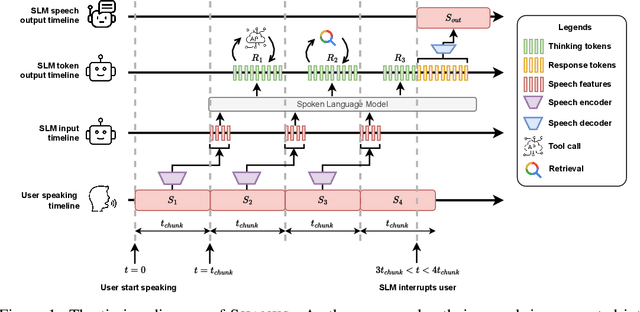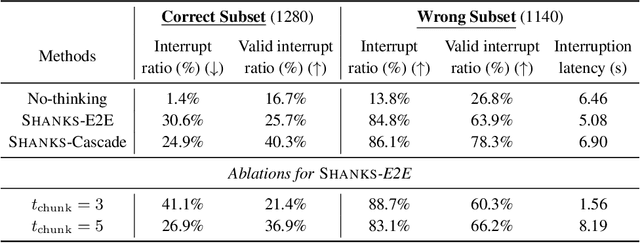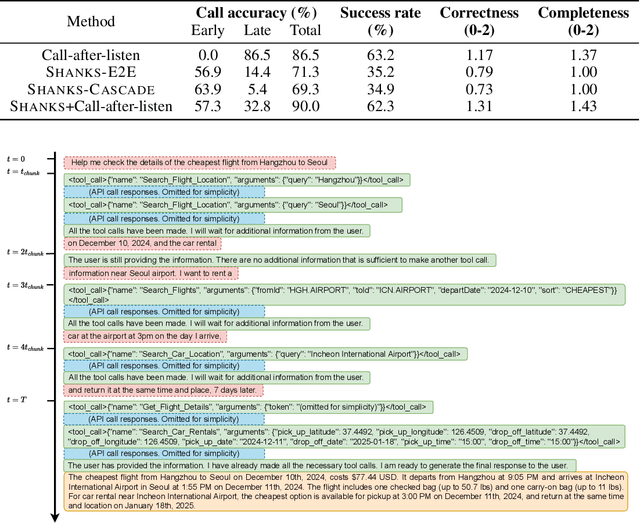Cheng-Han Chiang
SHANKS: Simultaneous Hearing and Thinking for Spoken Language Models
Oct 08, 2025



Abstract:Current large language models (LLMs) and spoken language models (SLMs) begin thinking and taking actions only after the user has finished their turn. This prevents the model from interacting during the user's turn and can lead to high response latency while it waits to think. Consequently, thinking after receiving the full input is not suitable for speech-to-speech interaction, where real-time, low-latency exchange is important. We address this by noting that humans naturally "think while listening." In this paper, we propose SHANKS, a general inference framework that enables SLMs to generate unspoken chain-of-thought reasoning while listening to the user input. SHANKS streams the input speech in fixed-duration chunks and, as soon as a chunk is received, generates unspoken reasoning based on all previous speech and reasoning, while the user continues speaking. SHANKS uses this unspoken reasoning to decide whether to interrupt the user and to make tool calls to complete the task. We demonstrate that SHANKS enhances real-time user-SLM interaction in two scenarios: (1) when the user is presenting a step-by-step solution to a math problem, SHANKS can listen, reason, and interrupt when the user makes a mistake, achieving 37.1% higher interruption accuracy than a baseline that interrupts without thinking; and (2) in a tool-augmented dialogue, SHANKS can complete 56.9% of the tool calls before the user finishes their turn. Overall, SHANKS moves toward models that keep thinking throughout the conversation, not only after a turn ends. Animated illustrations of Shanks can be found at https://d223302.github.io/SHANKS/
DeSTA2.5-Audio: Toward General-Purpose Large Audio Language Model with Self-Generated Cross-Modal Alignment
Jul 03, 2025Abstract:We introduce DeSTA2.5-Audio, a general-purpose Large Audio Language Model (LALM) designed for robust auditory perception and instruction-following, without requiring task-specific audio instruction-tuning. Recent LALMs typically augment Large Language Models (LLMs) with auditory capabilities by training on large-scale, manually curated or LLM-synthesized audio-instruction datasets. However, these approaches have often suffered from the catastrophic forgetting of the LLM's original language abilities. To address this, we revisit the data construction pipeline and propose DeSTA, a self-generated cross-modal alignment strategy in which the backbone LLM generates its own training targets. This approach preserves the LLM's native language proficiency while establishing effective audio-text alignment, thereby enabling zero-shot generalization without task-specific tuning. Using DeSTA, we construct DeSTA-AQA5M, a large-scale, task-agnostic dataset containing 5 million training samples derived from 7,000 hours of audio spanning 50 diverse datasets, including speech, environmental sounds, and music. DeSTA2.5-Audio achieves state-of-the-art or competitive performance across a wide range of audio-language benchmarks, including Dynamic-SUPERB, MMAU, SAKURA, Speech-IFEval, and VoiceBench. Comprehensive comparative studies demonstrate that our self-generated strategy outperforms widely adopted data construction and training strategies in both auditory perception and instruction-following capabilities. Our findings underscore the importance of carefully designed data construction in LALM development and offer practical insights for building robust, general-purpose LALMs.
Reducing Object Hallucination in Large Audio-Language Models via Audio-Aware Decoding
Jun 08, 2025Abstract:Large Audio-Language Models (LALMs) can take audio and text as the inputs and answer questions about the audio. While prior LALMs have shown strong performance on standard benchmarks, there has been alarming evidence that LALMs can hallucinate what is presented in the audio. To mitigate the hallucination of LALMs, we introduce Audio-Aware Decoding (AAD), a lightweight inference-time strategy that uses contrastive decoding to compare the token prediction logits with and without the audio context. By contrastive decoding, AAD promotes the tokens whose probability increases when the audio is present. We conduct our experiment on object hallucination datasets with three LALMs and show that AAD improves the F1 score by 0.046 to 0.428. We also show that AAD can improve the accuracy on general audio QA datasets like Clotho-AQA by 5.4% to 10.3%. We conduct thorough ablation studies to understand the effectiveness of each component in AAD.
Audio-Aware Large Language Models as Judges for Speaking Styles
Jun 06, 2025Abstract:Audio-aware large language models (ALLMs) can understand the textual and non-textual information in the audio input. In this paper, we explore using ALLMs as an automatic judge to assess the speaking styles of speeches. We use ALLM judges to evaluate the speeches generated by SLMs on two tasks: voice style instruction following and role-playing. The speaking style we consider includes emotion, volume, speaking pace, word emphasis, pitch control, and non-verbal elements. We use four spoken language models (SLMs) to complete the two tasks and use humans and ALLMs to judge the SLMs' responses. We compare two ALLM judges, GPT-4o-audio and Gemini-2.5-pro, with human evaluation results and show that the agreement between Gemini and human judges is comparable to the agreement between human evaluators. These promising results show that ALLMs can be used as a judge to evaluate SLMs. Our results also reveal that current SLMs, even GPT-4o-audio, still have room for improvement in controlling the speaking style and generating natural dialogues.
TRACT: Regression-Aware Fine-tuning Meets Chain-of-Thought Reasoning for LLM-as-a-Judge
Mar 06, 2025Abstract:The LLM-as-a-judge paradigm uses large language models (LLMs) for automated text evaluation, where a numerical assessment is assigned by an LLM to the input text following scoring rubrics. Existing methods for LLM-as-a-judge use cross-entropy (CE) loss for fine-tuning, which neglects the numeric nature of score prediction. Recent work addresses numerical prediction limitations of LLM fine-tuning through regression-aware fine-tuning, which, however, does not consider chain-of-thought (CoT) reasoning for score prediction. In this paper, we introduce TRACT (Two-stage Regression-Aware fine-tuning with CoT), a method combining CoT reasoning with regression-aware training. TRACT consists of two stages: first, seed LLM is fine-tuned to generate CoTs, which serve as supervision for the second stage fine-tuning. The training objective of TRACT combines the CE loss for learning the CoT reasoning capabilities, and the regression-aware loss for the score prediction. Experiments across four LLM-as-a-judge datasets and two LLMs show that TRACT significantly outperforms existing methods. Extensive ablation studies validate the importance of each component in TRACT.
Large Language Model as an Assignment Evaluator: Insights, Feedback, and Challenges in a 1000+ Student Course
Jul 07, 2024



Abstract:Using large language models (LLMs) for automatic evaluation has become an important evaluation method in NLP research. However, it is unclear whether these LLM-based evaluators can be applied in real-world classrooms to assess student assignments. This empirical report shares how we use GPT-4 as an automatic assignment evaluator in a university course with 1,028 students. Based on student responses, we find that LLM-based assignment evaluators are generally acceptable to students when students have free access to these LLM-based evaluators. However, students also noted that the LLM sometimes fails to adhere to the evaluation instructions. Additionally, we observe that students can easily manipulate the LLM-based evaluator to output specific strings, allowing them to achieve high scores without meeting the assignment rubric. Based on student feedback and our experience, we provide several recommendations for integrating LLM-based evaluators into future classrooms.
Merging Facts, Crafting Fallacies: Evaluating the Contradictory Nature of Aggregated Factual Claims in Long-Form Generations
Feb 23, 2024



Abstract:Long-form generations from large language models (LLMs) contains a mix of factual and non-factual claims, making evaluating factuality difficult. To evaluate factual precision of long-form generations in a more fine-grained way, prior works propose to decompose long-form generations into multiple verifiable facts and verify those facts independently. The factuality of the generation is the proportion of verifiable facts among all the facts. Such methods assume that combining factual claims forms a factual paragraph. This paper shows that the assumption can be violated due to entity ambiguity. We show that LLMs can generate paragraphs that contain verifiable facts, but the facts are combined to form a non-factual paragraph due to entity ambiguity. We further reveal that existing factual precision metrics, including FActScore and citation recall, cannot properly evaluate the factuality of these non-factual paragraphs. To address this, we introduce an enhanced metric, D-FActScore, specifically designed for content with ambiguous entities. We evaluate the D-FActScores of people biographies generated with retrieval-augmented generation (RAG). We show that D-FActScore can better assess the factuality of paragraphs with entity ambiguity than FActScore. We also find that four widely used open-source LLMs tend to mix information of distinct entities to form non-factual paragraphs.
Advancing Large Language Models to Capture Varied Speaking Styles and Respond Properly in Spoken Conversations
Feb 20, 2024Abstract:In spoken dialogue, even if two current turns are the same sentence, their responses might still differ when they are spoken in different styles. The spoken styles, containing paralinguistic and prosodic information, mark the most significant difference between text and speech modality. When using text-only LLMs to model spoken dialogue, text-only LLMs cannot give different responses based on the speaking style of the current turn. In this paper, we focus on enabling LLMs to listen to the speaking styles and respond properly. Our goal is to teach the LLM that "even if the sentences are identical if they are spoken in different styles, their corresponding responses might be different". Since there is no suitable dataset for achieving this goal, we collect a speech-to-speech dataset, StyleTalk, with the following desired characteristics: when two current speeches have the same content but are spoken in different styles, their responses will be different. To teach LLMs to understand and respond properly to the speaking styles, we propose the Spoken-LLM framework that can model the linguistic content and the speaking styles. We train Spoken-LLM using the StyleTalk dataset and devise a two-stage training pipeline to help the Spoken-LLM better learn the speaking styles. Based on extensive experiments, we show that Spoken-LLM outperforms text-only baselines and prior speech LLMs methods.
REBORN: Reinforcement-Learned Boundary Segmentation with Iterative Training for Unsupervised ASR
Feb 06, 2024Abstract:Unsupervised automatic speech recognition (ASR) aims to learn the mapping between the speech signal and its corresponding textual transcription without the supervision of paired speech-text data. A word/phoneme in the speech signal is represented by a segment of speech signal with variable length and unknown boundary, and this segmental structure makes learning the mapping between speech and text challenging, especially without paired data. In this paper, we propose REBORN, Reinforcement-Learned Boundary Segmentation with Iterative Training for Unsupervised ASR. REBORN alternates between (1) training a segmentation model that predicts the boundaries of the segmental structures in speech signals and (2) training the phoneme prediction model, whose input is a segmental structure segmented by the segmentation model, to predict a phoneme transcription. Since supervised data for training the segmentation model is not available, we use reinforcement learning to train the segmentation model to favor segmentations that yield phoneme sequence predictions with a lower perplexity. We conduct extensive experiments and find that under the same setting, REBORN outperforms all prior unsupervised ASR models on LibriSpeech, TIMIT, and five non-English languages in Multilingual LibriSpeech. We comprehensively analyze why the boundaries learned by REBORN improve the unsupervised ASR performance.
Over-Reasoning and Redundant Calculation of Large Language Models
Jan 21, 2024Abstract:Large language models (LLMs) can solve problems step-by-step. While this chain-of-thought (CoT) reasoning boosts LLMs' performance, it is unclear if LLMs \textit{know} when to use CoT and whether those CoT are always necessary to answer the question. This paper shows that LLMs tend to generate redundant calculations and reasoning on a manually constructed math QA dataset, GSM8K-Zero. GSM8K-Zero is constructed such that the questions can be answered without any calculations, but LLMs, including Llama-2 models and Claude-2, tend to generate lengthy and unnecessary calculations to answer the questions. We also conduct experiments to explain why LLMs generate redundant calculations and reasonings. GSM8K-Zero is publicly available at https://github.com/d223302/Over-Reasoning-of-LLMs and https://huggingface.co/datasets/dcml0714/GSM8K-Zero.
 Add to Chrome
Add to Chrome Add to Firefox
Add to Firefox Add to Edge
Add to Edge